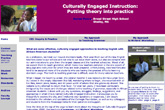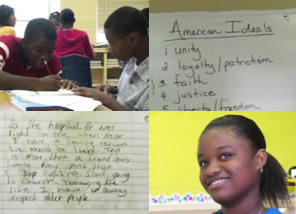 Collections
Collections  CASTL K12
CASTL K12 | CASTL K-12 Education |
The Carnegie Academy for the Scholarship of Teaching and Learning in K-12 EducationWelcome to the CASTL K-12 Collection. The collection from the Carnegie Academy for the Scholarship of Teaching and Learning in K-12 Education (CASTL K-12) presents the work of elementary and secondary teachers who investigated their teaching using a scholarly method. The representations in this collection were produced in conjunction with web developers who learned how best to support this kind of documentation.The sites found here include multimedia projects from nine secondary school and six elementary school teachers. Each project provides a unique perspective and format for sharing the complex work of teaching. These sites are also found in the Inside Teaching Collection, where they were transformed into curriculum materials for teacher educators. |
 Culturally Engaged Instruction (CEI): Putting theory into practice
Culturally Engaged Instruction (CEI): Putting theory into practice
As an English teacher at a rural all-Black high school
in the Mississippi Delta, Renee Moore enjoyed a genuine fellowship with
her students, many of whom she worked with outside of school in church
and community activities. Lessons in literature and writing went
reasonably well (for a beginning teacher), but when she started to teach
grammar, her students seemed to "hit a brick wall." She had two
simultaneous responses to the wall. She immediately started searching
for and experimenting with more effective grammar instructional
methodologies, and she began what would become a career long
action-research study on the issues surrounding the teaching of standard
American English to African American students.
Created: 2006-08-01
 Human
Agency, Social Action and Classroom Practices: What happens when
teachers move over to allow students to pave their own path towards
enacting change?
Human
Agency, Social Action and Classroom Practices: What happens when
teachers move over to allow students to pave their own path towards
enacting change?
Vanessa Brown's work focuses on the students and
classroom practices of her ninth grade English/Language Arts classes. It
grew out of the tensions that arose when her beliefs about the
juxtaposition of social action and classroom practices collided with the
realities of socio-economic status, personal agency, social and
emotional stability and student choice and voice. Through the stories of
three urban high school youth who actually represent hundreds of others
with similar stories, she contributes to and challenges the discourse
regarding critical pedagogy in urban education. Her video interlaces
both music and photos to represent the dual nature of the students'
lives, which is both static and shifting.
Created: 2003-11-24
 The
Development and Use of Representations in Teaching and Learning about
Problem Solving: Exploring the Rule of 3 in Elementary School
Mathematics
The
Development and Use of Representations in Teaching and Learning about
Problem Solving: Exploring the Rule of 3 in Elementary School
Mathematics
Tim Boerst has explored instructional approaches that
foster the development of representational skill and routine use of
multiple representations in problem solving. In particular he has used
the "Rule of 3" (a structure employed in calculus reform materials that
highlights the use of numerical, algebraic, and/or graphic
representations in mathematical learning) to see whether an emphasis on
multiple representations would deepen mathematical learning
opportunities for a wide variety of students.
Created: 2003-11-24
 Learning
from our conversations in English: Using video in the bilingual
classroom as a tool for reflection on English language learning and
teaching
Learning
from our conversations in English: Using video in the bilingual
classroom as a tool for reflection on English language learning and
teaching
Since beginning her teaching career, Sarah Capitelli
has been concerned with how to best meet the needs of her English
language learners during English language development class. In
particular, she is concerned with how to help them create a strong
foundation for their learning of English. In her research, she has
discovered that her school's program has not worked for the most needy
students. Her research questions were 1) What structures support English
language development in the classroom? 2) How do conversations between
students support English language learning? 3) What strategies do good
English language learners use? And 4) How can video be used to give
students a window into their English language learning?
Created: 2003-11-24
 A Friend of Their Minds: Capitalizing on the Oral Tradition of My African American Students
A Friend of Their Minds: Capitalizing on the Oral Tradition of My African American Students
Yvonne Divans Hutchinson is a National Board certified
teacher who has focused for many years on developing strategies to
engage all her students in substantive discussions of literary texts and
the issues those texts raise for their own lives. In this approach, she
builds on the oral traditions of her students African-American and
Latino cultures and seeks to support the development of their literacy
skills through high standards, explicit expectations, and rigorous
literature experiences. Her online "class anatomy" (a documentation and
analysis of one instructional period) juxtaposes video clips with
commentary and samples of classroom documents. In the video clips,
Hutchinson reflects on her expectations for the class, a student orally
presents the "class scribe" notes from the previous day, the students
engage in small group and large group discussion about a racially
charged literary selection that had been assigned the night before, and
after the class, four students reflect on their experiences in
Hutchinson's classroom, and how her rigorous approach and emphasis on
dialogue and diversity prepares them for other academic work.
Created: 2003-01-01
 Heterogeneous Grouping and High Standards in an Untracked Advanced English Class
Heterogeneous Grouping and High Standards in an Untracked Advanced English Class
This website describes Joan Cone's teaching journey to
address challenges of diversity, inequity, and achievement in her High
School English classroom. At El Cerrito High School, Cone has been an
integral part of an ongoing struggle to detrack the English curriculum.
Over the past few years, her thinking has built from an investigation
into the "co-construction of low achievement," to address what she's
learned by developing essential practices to construct students as
achievers in her classroom and the school.
Created: 2003-01-01
 Pio Pico Researchers Participatory Action Research: From Classroom to Community, Transforming Teaching and Learning
Pio Pico Researchers Participatory Action Research: From Classroom to Community, Transforming Teaching and Learning
Emily Wolk is a teacher of a group of students, aged
8-11 years old, called the Pio Pico Researchers. Together, since the
group started in 1996, the group convinced the city of Santa Ana to
install a signal light at one of the most dangerous intersections in the
city, in the immediate vicinity of Pio Pico School. Wolk used an
alternative inquiry method called Participatory Action-Research (PAR)
with her students. The children used radar guns, plotted data on a
computerized mapping system called GIS, and presented at City Hall.
Through their work to improve pedestrian safety, the students not only
learned the basic skills necessary to succeed in school; they also
learned the basic skills necessary to transform their world.
Created: 2002-01-01
 Setting Up a Successful Journalistic Learning Community
Setting Up a Successful Journalistic Learning Community
In this website, Wojcicki describes how participation
in a journalistic learning community can motivate even the most
recalcitrant student. The website includes sample copies of the
newspaper, The Campanile and the magazine, Verde, which are examples of
the kinds of student outcomes that can be achieved when students are
excited about learning and have ownership of their learning and the
product of their learning: the publications. Wojcicki's students have
won several major national and international competitions over the past
fifteen years. Both publications are self-supporting which means that
all students in the program are responsible for learning how to sell ads
and to interact with the community. This helps students develop
important interpersonal skills and also acts as a public relations
mechanism for the school and for the newspaper. It also brings the
community closer to the school and makes people feel as though they are
active participants in the education process.
Created: 2002-01-01
 Looking Beyond Themselves: Preparing Students to Become Invested Members of Their Community
Looking Beyond Themselves: Preparing Students to Become Invested Members of Their Community
As a sixth grade teacher, Pfitzner struggled to find a
way to truly reach her students. She wanted to help her students find a
deeper connection to what they were learning, allowing them to feel
ownership of their knowledge. She developed a project based on community
activism to help her students escape the cliques and disconnectedness
so common to sixth graders in her school. Pfitzner documented this
journey as she and her students identified and addressed a need in their
community for a non-fishing oriented park for children and their
families. This website reveals the pedagogical strategies she used to
allow students the opportunity to feel true ownership of their learning,
and highlights key turning points in the process of watching eleven and
twelve year olds grow from passive learners to inspired citizens.
Created: 2002-01-01
 Playing with the Possible
Playing with the Possible
This website documents a high school drama class in
which students wrote and performed their own autobiographical
monologues. The site is centered around video clips that illustrate how
students used drama to develop, express, and debate understandings
around contested issues in their lives. Pincus also reflects on the
nature of teacher inquiry and its role in her personal and professional
development.
Created: 2001-01-01
 Making Change Visible
Making Change Visible
This site documents the changes made in one
fifteen-minute reading/writing activity in first grade over one entire
school year. The site shows the revisions necessary to create an
effective learning experience for all students and provides examples of
the development of students' work. There are also excerpts from Hurley's
own journal, her audio commentary, and a video tour of her classroom,
and her reflections on the change process as a whole.
Created: 2001-01-01
 Multiple Measures of Student Achievement in an Interdisciplinary Unit on the Harlem Renaissance
Multiple Measures of Student Achievement in an Interdisciplinary Unit on the Harlem Renaissance
This website shows the culmination of a 5th-grade class
interdisciplinary project on the Harlem Renaissance: a student-created
museum and exhibition. The site uses video comments of students,
teachers, and parents work to provide a multiplicity of perspectives on
the project, and offers links to Lyons philosophy and year-long
curriculum.
Created: 2001-01-01
 The Mission Hill School (2001)
The Mission Hill School (2001)
This website is built around a documentary film on the
portfolio graduation process at the Mission Hill School. The documentary
and the site depict both the development of the students' written work
and presentations, and the efforts of the faculty to implement and
refine their approach. Sections of the film are juxtaposed with school
documents and examples of students' work.
Created: 2001-01-01
 Creating space for diverse perspectives and student learning
Creating space for diverse perspectives and student learning
This website is an "illustrated case" of the teaching
of a high school English class on the literature of social vision and
social change. The case examines the use of multicultural materials in a
standard English class and the instructors' efforts to refine the
course as the year progressed. The website offers video clips of
classroom activities, teacher reflections, and examples of student work.
Created: 2001-01-01
 Creating a Community of Learners: Lessons from a High School Journalism Program
Creating a Community of Learners: Lessons from a High School Journalism Program
This site provides an example and illustration of a
learning community in a high school journalism class. The site is drawn
from the teacher's reflections as well as a researcher's studies in this
classroom. The site describes the key components of learning
communities, their manifestation in this classroom, videos of classroom
interactions, and a related bibliography.
Created: 2000-01-01
